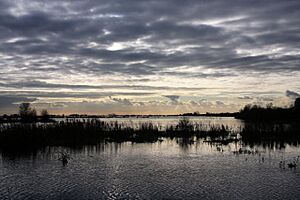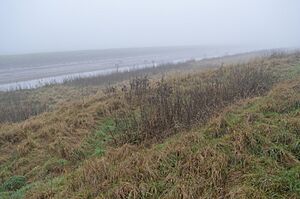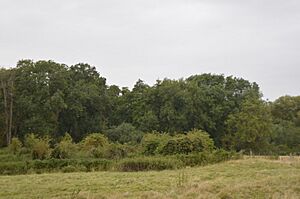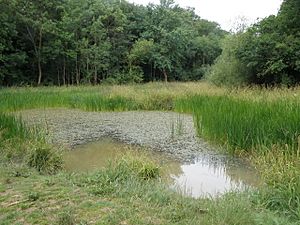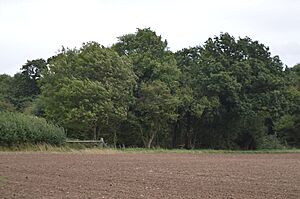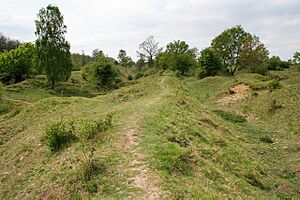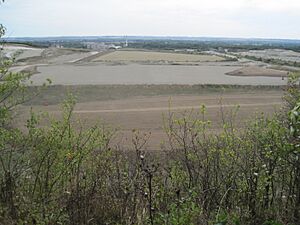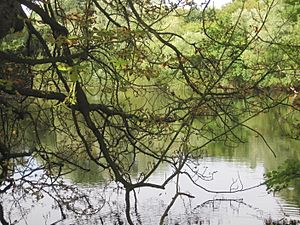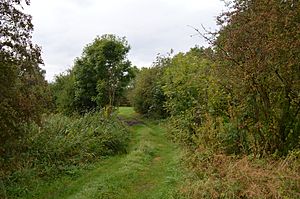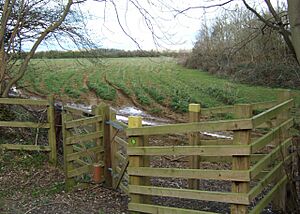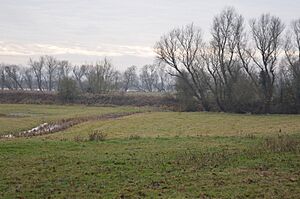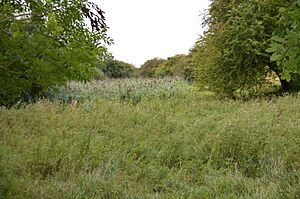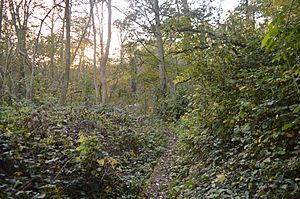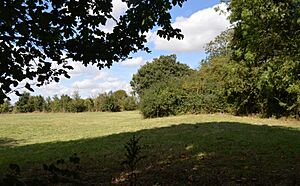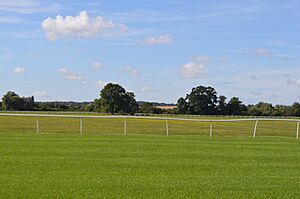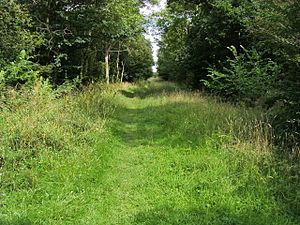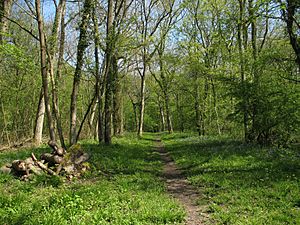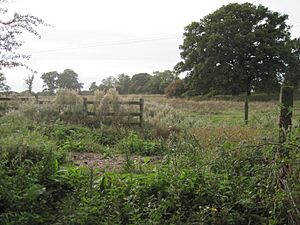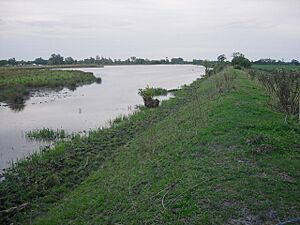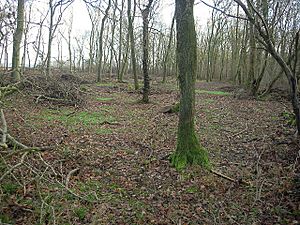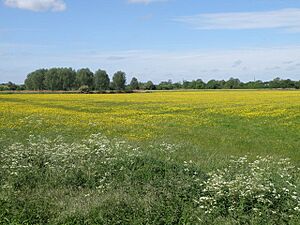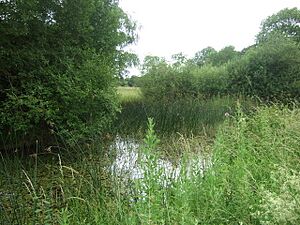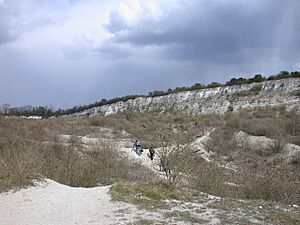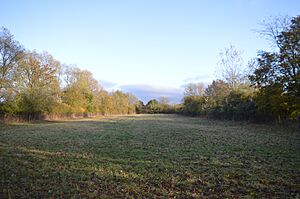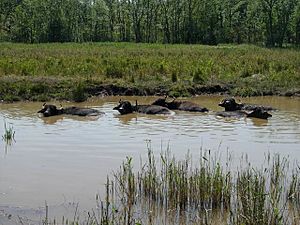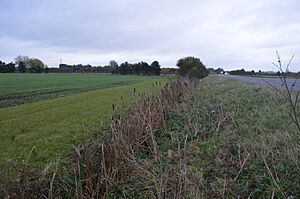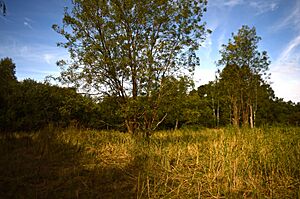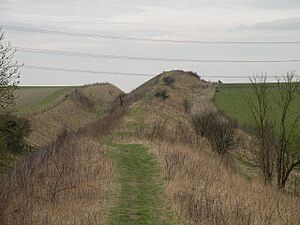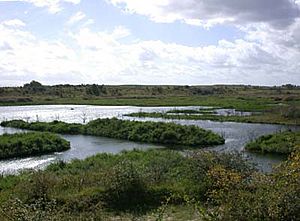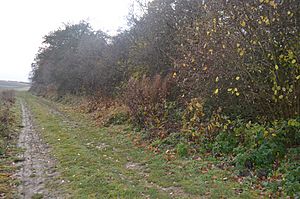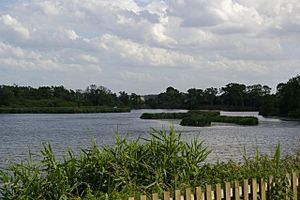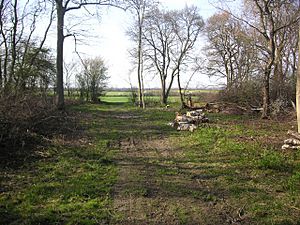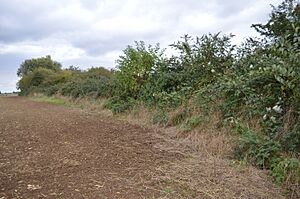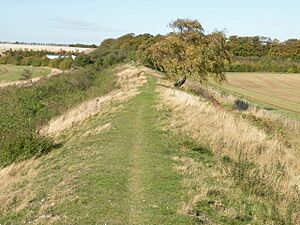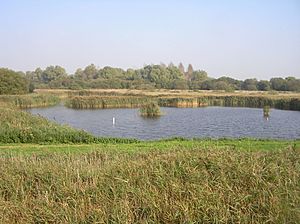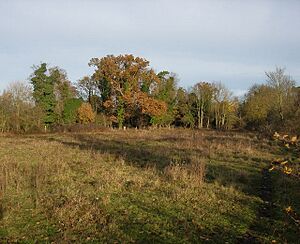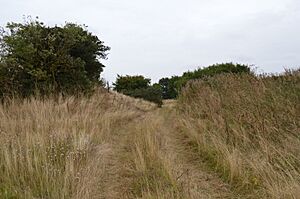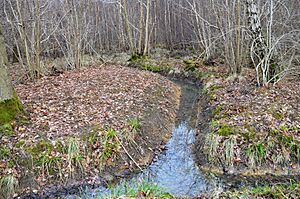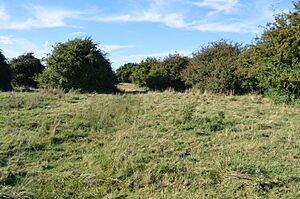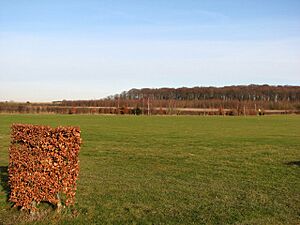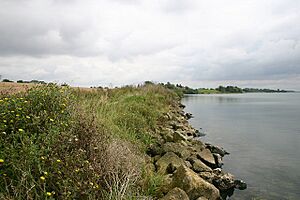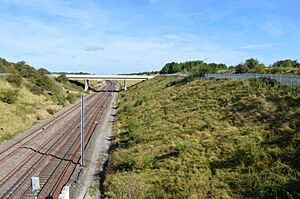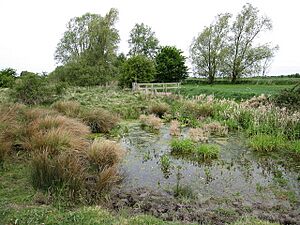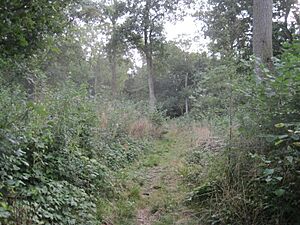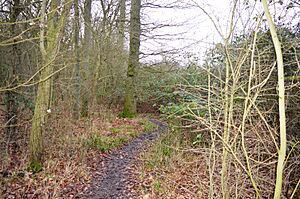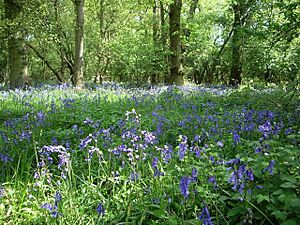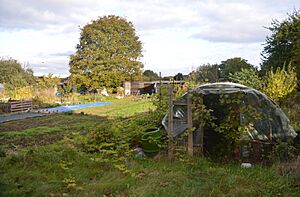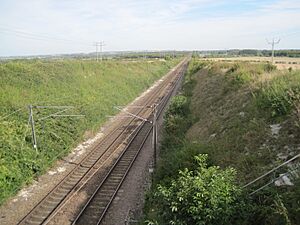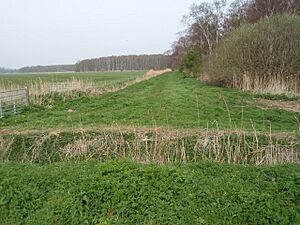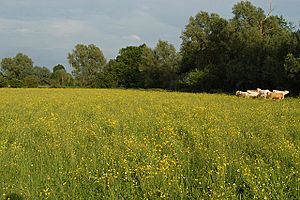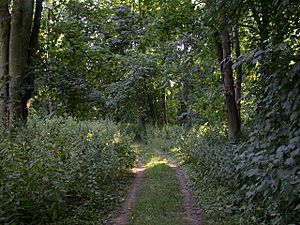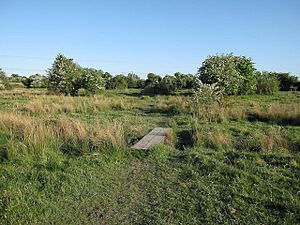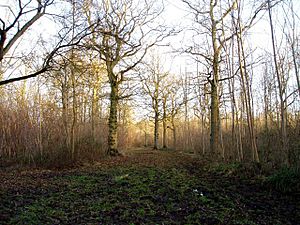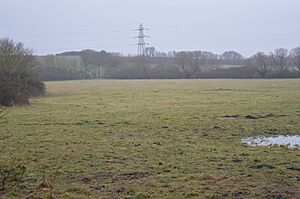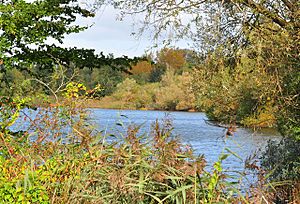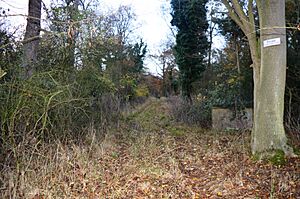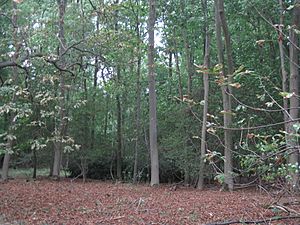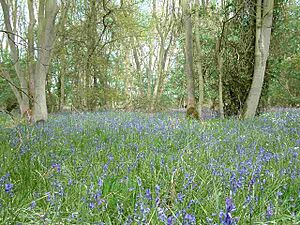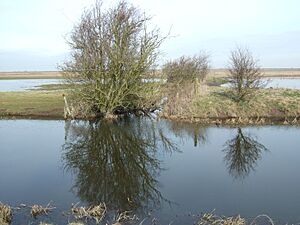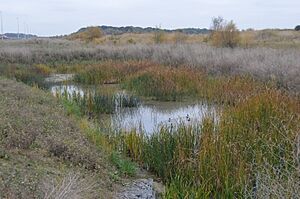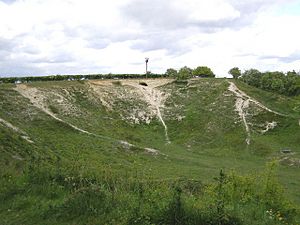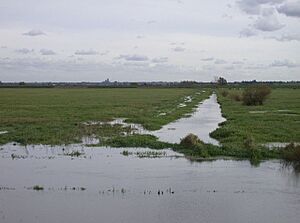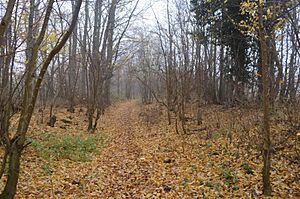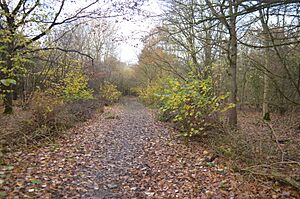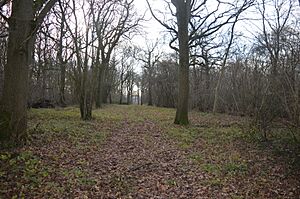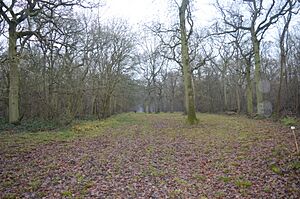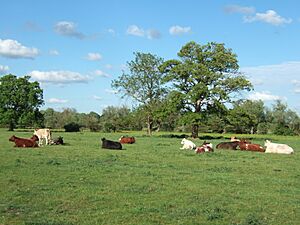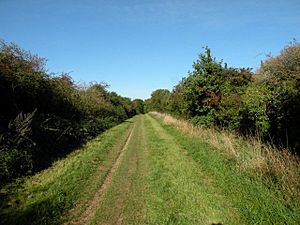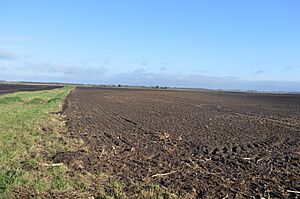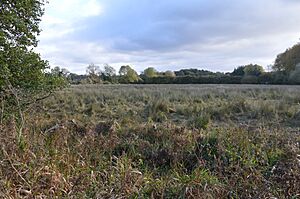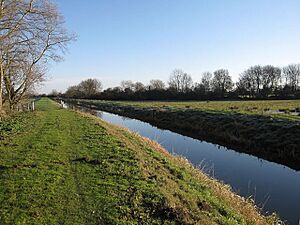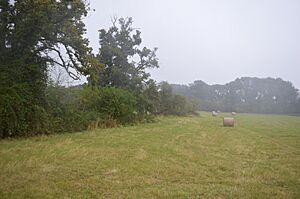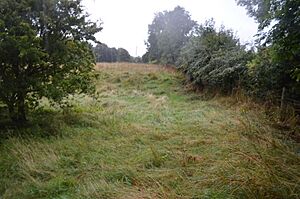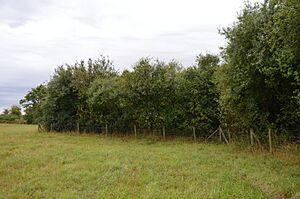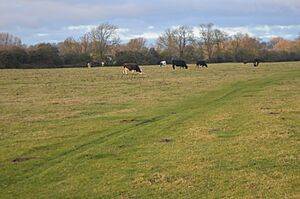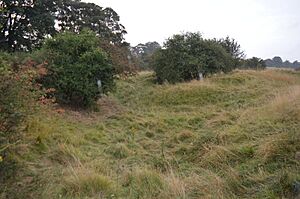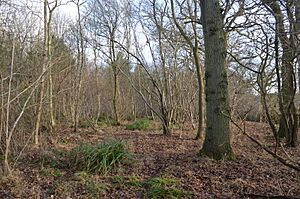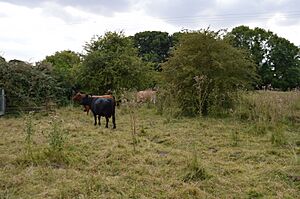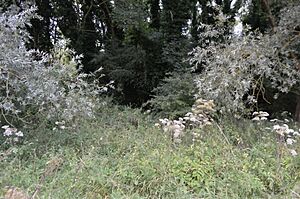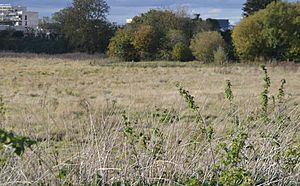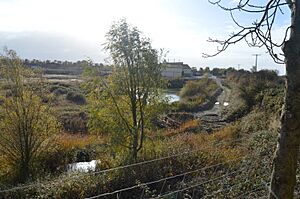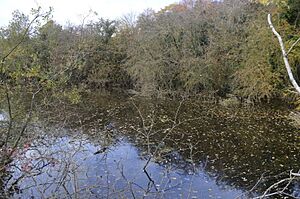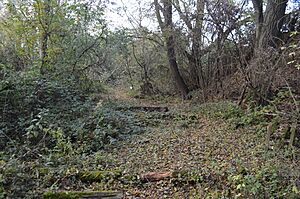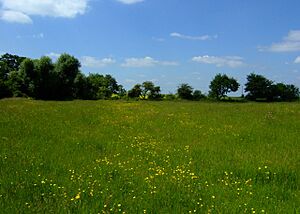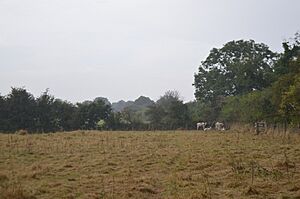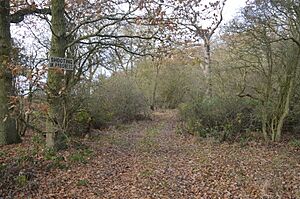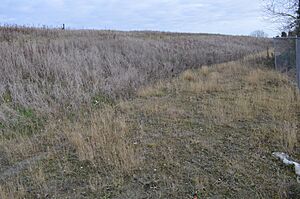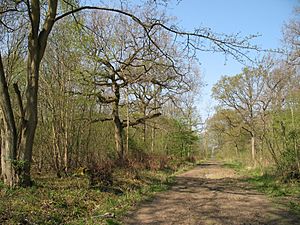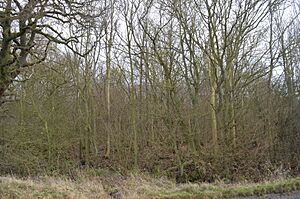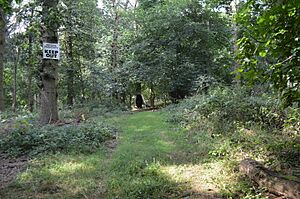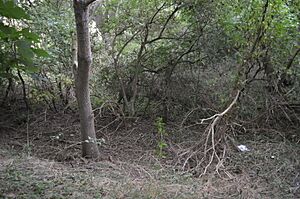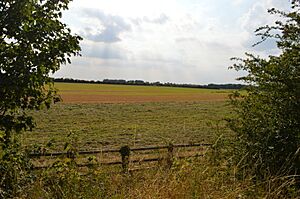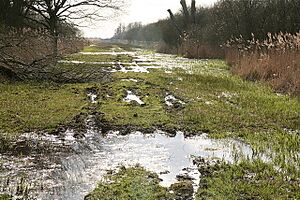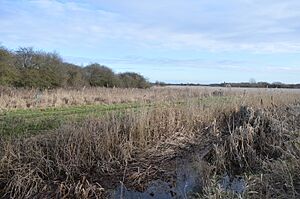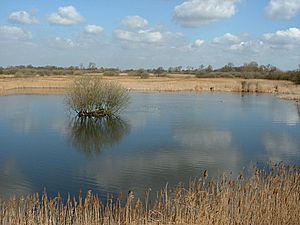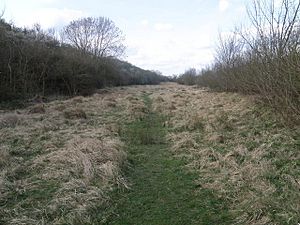List of Sites of Special Scientific Interest in Cambridgeshire facts for kids
Cambridgeshire is a county in eastern England. It covers a large area and is home to over 840,000 people. Two important rivers, the Nene and the Great Ouse, flow through it. The famous University of Cambridge, started in the 1200s, made the county a major place for learning. A big part of Cambridgeshire is in an area called The Fens. This land used to be very wet, but people drained it over many centuries, making it good for farming.
In 1974, the county as we know it today was formed. This included most of the historic area of Huntingdonshire. Local decisions are made by the Cambridgeshire County Council and the Peterborough City Council. Peterborough is a special area that manages itself. Under the county council, there are five smaller councils: Cambridge City, South Cambridgeshire, East Cambridgeshire, Huntingdonshire, and Fenland.
In England, special places called Sites of Special Scientific Interest (SSSIs) are chosen by Natural England. This group works to protect England's natural environment. When a place is named an SSSI, it gets legal protection. This helps keep its important wildlife and geological features safe. As of March 2017, Cambridgeshire has 99 SSSIs. Most of these (88) are important for their plants and animals. Ten are special for their geology (rocks and landforms). One site is important for both!
The biggest SSSI is Ouse Washes, which is about 2,513 hectares (over 6,200 acres). Part of it is also in Norfolk. This area is super important for birds that spend the winter there or come to breed. You can see birds like teal, pintail, and wigeon. The smallest SSSI is Delph Bridge Drain, only 0.1 hectares (about a quarter of an acre). It's special because a plant called fen ragwort was found there. People thought this plant had died out in Britain back in 1857! The only SSSI important for both its wildlife and geology is Ely Pits and Meadows. This site is home to many bitterns, a type of bird. It also has fossils of sauropod dinosaurs and pliosaur marine reptiles from the Jurassic period.
What the Symbols Mean
Why a Site is Special
How You Can Visit
|
Other Special Names
|
Special Sites in Cambridgeshire
| Top - 0-9 A B C D E F G H I J K L M N O P Q R S T U V W X Y Z |
| Site name | Photograph | B | G | Area | Public access |
Location | Other classifications |
Map | Citation | Description |
|---|---|---|---|---|---|---|---|---|---|---|
| Adventurers' Land | 10.1 hectares (25 acres) | YES | March 52°35′53″N 0°00′29″E / 52.598°N 0.008°E TF361019 |
GCR | Map | Citation | This site is important for studying how sea levels have changed over the last 11,700 years. It has five layers of peat that show sea levels from 6,400 to 1,850 years ago. The oldest layer shows when the sea first came into The Fens. | |||
| Alder Carr | 6.7 hectares (17 acres) | NO | Hildersham 52°07′01″N 0°15′04″E / 52.117°N 0.251°E TL542489 |
Map | Citation | This is a wet valley with alder trees growing on fen peat. This type of woodland is very rare in East Anglia now. You can find plants like angelica and meadowsweet here. This habitat is also very important for insects and other small creatures. | ||||
| Aversley Wood | 62.3 hectares (154 acres) | YES | Sawtry 52°25′23″N 0°17′38″W / 52.423°N 0.294°W TL161819 |
WT | Map | Citation | This wood has ash and maple trees growing on heavy clay soil. Much of it has been woodland since before the Middle Ages. This means it has many different kinds of plants and animals. One part of the wood was farmed until about 1350. It still shows medieval ridge and furrow patterns and has fewer plant types than the older parts of the forest. | |||
| Balsham Wood | 35.0 hectares (86 acres) | NO | Balsham 52°07′19″N 0°19′05″E / 52.122°N 0.318°E TL588496 |
Map | Citation | This site has one of the last remaining areas of ash and maple woodland. It grows on chalky clay soil. You can find many different plants here, including the rare oxlip flower. There are also various shrubs like dogwood. Open grassy paths create even more places for wildlife to live. | ||||
| Barnack Hills & Holes | 23.5 hectares (58 acres) | YES | Barnack 52°37′44″N 0°24′43″W / 52.629°N 0.412°W TF076046 |
NCR, NNR, SAC | Map | Citation | This site used to be a mineral quarry. Now, it's a grassland on Jurassic limestone. Sheep grazing and scrub control help manage the area. It has many different plants, including some that are rare in the country, like pasque flowers. | |||
| Barrington Chalk Pit | 97.1 hectares (240 acres) | FP | Barrington 52°08′31″N 0°01′59″E / 52.142°N 0.033°E TL392512 |
GCR | Map | Citation | This large quarry is the only place left where you can see the Cretaceous Cambridge Greensand rock layer. Fossils found here include brachiopods (shellfish) and fish teeth. Above this layer are thick sections of chalk and Totternhoe Stone. | |||
| Barrington Pit | 3.8 hectares (9.4 acres) | NO | Barrington 52°07′23″N 0°01′08″E / 52.123°N 0.019°E TL383491 |
GCR | Map | Citation | This site is very important for its mammal fossils. You can find fossils of hippopotamuses, straight-tusked elephants, lions, and aurochs (an extinct type of wild cattle). These fossils likely date back to a warm period called the Eemian, about 130,000 to 115,000 years ago. | |||
| Bassenhally Pit | 8.6 hectares (21 acres) | NO | Whittlesey 52°34′08″N 0°06′14″W / 52.569°N 0.104°W TL286985 |
Map | Citation | This used to be a gravel quarry. Now, it has many different habitats like a pond, marshes, grassland, and woodland. The marsh area is rare in the country. It has unusual plants like jointed rush, creeping bent, and early marsh-orchid. | ||||
| Bedford Purlieus | 214.3 hectares (530 acres) | YES | Wansford 52°34′59″N 0°27′54″W / 52.583°N 0.465°W TL041995 |
NCR, NNR | Map | Citation | This is an ancient woodland with different types of oak and ash trees. It also has many different plants, including ramsons, lily-of-the-valley, columbines, and fly orchids. | |||
| Berry Fen | 15.3 hectares (38 acres) | NO | Earith 52°21′04″N 0°01′19″E / 52.351°N 0.022°E TL378745 |
Map | Citation | This grassland often floods in the winter. It's used by wildfowl (water birds) in winter, especially Bewick's swans. This happens when the nearby Ouse Washes get too deep. You can find wetland plants here like marsh ragwort. | ||||
| Bonemills Hollow | 17.5 hectares (43 acres) | NO | Wittering 52°35′56″N 0°28′23″W / 52.599°N 0.473°W TF035012 |
Map | Citation | This valley has marshland and grassland on Jurassic limestone. The marsh is at the bottom of the valley. You'll find plants like lesser pond-sedge and different types of rushes here. | ||||
| Brackland Rough | 10.7 hectares (26 acres) | YES | Fordham 52°18′07″N 0°23′38″E / 52.302°N 0.394°E TL633698 |
WTBCN | Map | Citation | This is a wet woodland site with alder trees that grow back from their stumps (coppice). You'll also see ash, crack willow, and silver birch trees. The ground has tall fen plants and herbs like marsh marigold and yellow flag. | |||
| Brampton Meadow | 1.0 hectare (2.5 acres) | NO | Brampton 52°19′59″N 0°15′07″W / 52.333°N 0.252°W TL192720 |
Map | Citation | This meadow has many different plant species. It's a rare type of grassland on chalky clay. You can find plants like quaking-grass, adder's tongue fern, cowslip, and green-winged orchid here. | ||||
| Brampton Racecourse | 21.1 hectares (52 acres) | NO | Brampton 52°20′06″N 0°14′10″W / 52.335°N 0.236°W TL203722 |
Map | Citation | This site is a grassland rich in different plant species. It's a rare habitat in Cambridgeshire. It sits in the flood plain of Alconbury Brook. Plants include salad burnet, pepper-saxifrage, and the largest group of green-winged orchids in the county. | ||||
| Brampton Wood | 132.1 hectares (326 acres) | YES | Brampton 52°18′58″N 0°16′12″W / 52.316°N 0.27°W TL179701 |
WTBCN | Map | Citation | This is one of the few remaining ancient woodlands in the county. It's a wet ash and maple wood on heavy clay soil. The paths through the wood have many different grassland plants. These include yellow pimpernel and devil's-bit scabious. | |||
| Buff Wood | 15.8 hectares (39 acres) | WTPR | Hatley 52°08′10″N 0°07′41″W / 52.136°N 0.128°W TL282503 |
WTBCN | Map | Citation | This woodland on boulder clay has a rich variety of life. It has many wildflowers, including oxlips and the uncommon green hellebore. You can also see butterflies like brimstones, large whites, orange-tips, and speckled woods. | |||
| Caldecote Meadows | 9.1 hectares (22 acres) | NO | Caldecote 52°12′04″N 0°01′44″W / 52.201°N 0.029°W TL348577 |
Map | Citation | This site is a grassland rich in herbs. It used to be common in the county but is now rare. It's managed in the traditional way, by cutting hay and grazing animals. Plants here include salad burnet and dropwort. | ||||
| Cam Washes | 166.5 hectares (411 acres) | YES | Wicken 52°19′01″N 0°15′07″E / 52.317°N 0.252°E TL536712 |
Map | Citation | This site is on the banks of the River Cam. It has pastures that flood during certain seasons. It's an important place for wildfowl and wading birds that come to spend the winter or breed. Breeding birds include snipe, redshank, gadwall, teal, and shovelers. | ||||
| Carlton Wood | 10.5 hectares (26 acres) | NO | Great Bradley 52°09′00″N 0°24′58″E / 52.15°N 0.416°E TL654529 |
Map | Citation | This wood has one of the best groups of hornbeam trees in the county. Other trees include ash, field maple, hazel, and oak. There are many different plants typical of ancient woodlands, like oxlips and early-purple orchids. | ||||
| Castor Flood Meadows | 41.8 hectares (103 acres) | YES | Peterborough 52°33′43″N 0°20′42″W / 52.562°N 0.345°W TL123972 |
Map | Citation | This site is on the banks of the River Nene. It's a small part of what used to be a much larger area of flood meadows. Plants here include slender tufted-sedges, early marsh-orchids, and the rare narrow-leaved water-dropwort. | ||||
| Castor Hanglands | 89.8 hectares (222 acres) | YES | Peterborough 52°36′04″N 0°21′07″W / 52.601°N 0.352°W TF117016 |
NCR, NNR | Map | Citation | This site has ancient ash and maple woodland, untouched grassland, and scrub. It's valuable for insects, including some rare species. There are also ponds and ditches with various water animals, like the warty newt. | |||
| Cherry Hinton Pit | 12.8 hectares (32 acres) | YES | Cambridge 52°10′48″N 0°10′05″E / 52.18°N 0.168°E TL483557 |
LNR, WTBCN | Map | Citation | These old chalk quarries have different habitats, including grassland and woodland. The site is an SSSI because it has four rare plants. Three of these are on the British Red List of Threatened Species. These are great pignut, moon carrot, and grape hyacinth. | |||
| Chettisham Meadow | 0.7 hectares (1.7 acres) | YES | Chettisham 52°25′23″N 0°15′54″E / 52.423°N 0.265°E TL541830 |
WTBCN | Map | Citation | This site is a grassland on chalky clay. You can still see signs of medieval farming here, like ridge and furrow patterns. Flowering plants include adder's tongue, cowslip, and the uncommon green-winged orchid. | |||
| Chippenham Fen and Snailwell Poor's Fen | 155.6 hectares (384 acres) | NO | Fordham 52°17′53″N 0°24′54″E / 52.298°N 0.415°E TL648694 |
NCR, NNR, Ramsar, SAC | Map | Citation | This site is very important for its many different wetland habitats. It's home to various birds and insects. It has diverse habitats and plants, with several rare species in its damp meadows. Many types of birds breed here, and you can find rare spiders and moths. | |||
| Delph Bridge Drain | 0.1 hectares (0.25 acres) | YES | Soham 52°22′01″N 0°18′00″E / 52.367°N 0.3°E TL567768 |
Map | Citation | This site is special because it has the only known group of fen ragwort plants in Britain. People thought this plant had died out in the UK in 1857. It was found again in 1971 when old seeds likely grew after the drain was dug out. | ||||
| Dernford Fen | 10.3 hectares (25 acres) | NO | Sawston 52°07′52″N 0°08′56″E / 52.131°N 0.149°E TL472503 |
Map | Citation | This site is a rare example of fen and carr (wet woodland) habitats that still exist. It also has dry grassland and scrub, along with ditches and a chalk stream. These different habitats are important for amphibians and reptiles. | ||||
| Devil's Dyke | 39.8 hectares (98 acres) | YES | Newmarket 52°13′55″N 0°21′32″E / 52.232°N 0.359°E TL612619 |
SAC, SM | Map | Citation | No one knows exactly when this dyke was built, but it was probably during the Anglo-Saxon period. It has a large area of chalk grassland with many different plant species. There are also areas of woodland and chalk scrub. The site has unusual plants like purple milk-vetch and pasque flowers. | |||
| Dogsthorpe Star Pit | 36.4 hectares (90 acres) | YES | Peterborough 52°36′29″N 0°12′43″W / 52.608°N 0.212°W TF212026 |
LNR, WTBCN | Map | Citation | This old brick pit is an SSSI mainly because of its insects, especially water beetles. It has 64 species of water beetles, including four that are on the British Red List of Threatened Species. | |||
| Elsworth Wood | 6.9 hectares (17 acres) | NO | Elsworth 52°14′20″N 0°04′48″W / 52.239°N 0.080°W TL312618 |
Map | Citation | This site has three different types of rare woodland. The main tree is coppiced field maple, which means it's cut back to grow new shoots. It has many different shrubs and a lot of oxlips. There are also several rare beetles here. | ||||
| Ely Pits and Meadows | 85.8 hectares (212 acres) | PP | Ely 52°24′11″N 0°16′59″E / 52.403°N 0.283°E TL554808 |
GCR, WTBCN | Map | Citation | This site has many fossils of reptiles from the Kimmeridgian period, about 155 million years ago. Its wildlife importance comes from its breeding birds, especially rare bitterns. | |||
| Eversden and Wimpole Woods | 66.6 hectares (165 acres) | YES | Great Eversden 52°09′36″N 0°02′06″W / 52.16°N 0.035°W TL345531 |
SAC | Map | Citation | Wimpole Wood is home to six types of bats, including the very rare barbastelle bat. Female barbastelles give birth and raise their young in tree cracks. Eversden Wood is a great example of a rare woodland type in lowland Britain, with ancient ash and field maple trees. | |||
| Eye Gravel Pit | 0.3 hectares (0.74 acres) | NO | Eye Green 52°36′58″N 0°11′06″W / 52.616°N 0.185°W TF230036 |
GCR | Map | Citation | This old gravel quarry has shells from the sea and some from land. These were left when the area was under the North Sea. This probably happened during a warm period called the Eemian, about 130,000 to 115,000 years ago. | |||
| Fleam Dyke | 11.8 hectares (29 acres) | YES | Fulbourn 52°09′36″N 0°15′58″E / 52.16°N 0.266°E TL551539 |
SM | Map | Citation | Fleam Dyke was one of 286 sites chosen by Charles Rothschild between 1912 and 1915. He picked them as important wildlife sites to protect. The steep sides of this earthwork have chalk grassland rich in different species. This habitat is rare in the county. | |||
| Fowlmere Watercress Beds | 39.9 hectares (99 acres) | YES | Melbourn 52°05′20″N 0°02′56″E / 52.089°N 0.049°E TL405454 |
RSPB | Map | Citation | A chalk stream flows through this nature reserve. It also has pools fed by chalk springs. Birds you might see here include kingfishers, water rails, corn buntings, and starlings. | |||
| Fulbourn Fen | 27.3 hectares (67 acres) | YES | Fulbourn 52°10′52″N 0°14′10″E / 52.181°N 0.236°E TL530560 |
WTBCN | Map | Citation | These are ancient meadows on chalky soil and peat. They have never been farmed, so they have many different plants and animals. Drier areas have herbs like cowslip and salad burnet. Wetter areas have tall fen plants. | |||
| Furze Hill | 5.8 hectares (14 acres) | NO | Hildersham 52°06′50″N 0°16′01″E / 52.114°N 0.267°E TL553486 |
Map | Citation | The site has steep banks of deep sandy gravel left by glaciers. It's one of the few sandy habitats in the county. There are several rare plants here, such as hoary cinquefoils, pasque flowers, and maiden pinks. | ||||
| Gamlingay Wood | 48.4 hectares (120 acres) | YES | Gamlingay 52°09′54″N 0°11′10″W / 52.165°N 0.186°W TL242534 |
WTBCN | Map | Citation | This is an ancient ash/maple woodland on sandy soil, which is unusual in lowland England. You'll find plants like dog's mercury, wood anemone, and the rare oxlip. The different soils mean there are many types of plants. Hundreds of species of mushrooms and toadstools also grow here. | |||
| Godmanchester Eastside Common | 29.7 hectares (73 acres) | YES | Godmanchester 52°19′30″N 0°08′20″W / 52.325°N 0.139°W TL269713 |
Map | Citation | This site has two fields separated by an old railway line. The habitats are chalky loam and chalky clay, both of which are unusual. The southern field still shows medieval ridge and furrow patterns from farming. | ||||
| Gog Magog Golf Course | 88.1 hectares (218 acres) | NO | Fulbourn 52°09′54″N 0°10′26″E / 52.165°N 0.174°E TL488541 |
Map | Citation | The golf course is a chalk grassland with many different plants. The main grasses are upright brome, red fescue, and false oat-grass. You can also find herbs like the nationally rare moon carrot and the locally rare perennial flax. | ||||
| Grafham Water | 806.3 hectares (1,992 acres) | YES | Grafham 52°17′49″N 0°19′08″W / 52.297°N 0.319°W TL147679 |
WTBCN | Map | Citation | This reservoir is important for the large numbers of great crested grebes, tufted ducks, and coots that spend the winter here. Many mute swans also gather here in late summer to moult their feathers. A pond on the site has a group of the nationally uncommon warty newt. | |||
| Great Stukeley Railway Cutting | 34.7 hectares (86 acres) | NO | Huntingdon 52°21′29″N 0°11′17″W / 52.358°N 0.188°W TL235748 |
Map | Citation | This site is a chalky clay grassland. It has plants that used to be common in the Huntingdonshire claylands but are now rare due to farming. Rabbits grazing and occasional burning help keep this habitat healthy. | ||||
| Great Wilbraham Common | 23.5 hectares (58 acres) | YES | Great Wilbraham 52°11′42″N 0°14′35″E / 52.195°N 0.243°E TL534576 |
Map | Citation | This is one of the largest remaining areas of grassland rich in different plant species in the county. Locally uncommon plants include purple milk-vetch, felwort, meadow saxifrage, and green-winged orchid. | ||||
| Hardwick Wood | 15.5 hectares (38 acres) | YES | Caldecote 52°11′56″N 0°01′19″W / 52.199°N 0.022°W TL354576 |
WTBCN | Map | Citation | This medieval wood is now managed by coppicing (cutting trees to encourage new growth). It's mainly ash and field maple. The oldest parts have oak trees with hazel and hawthorn underneath. Ground plants include early-purple orchid and yellow archangel. | |||
| Hayley Wood | 51.7 hectares (128 acres) | YES | Great Gransden 52°09′32″N 0°06′50″W / 52.159°N 0.114°W TL291529 |
NCR, WTBCN | Map | Citation | The soil in this wood is heavy and often wet, which is perfect for meadowsweet and oxlip plants. The number of oxlips dropped a lot because of too many deer. But since a fence was built in 2002, they have grown back. A very old parish boundary fence here, possibly from the 1000s, is also important for wildlife. | |||
| Hemingford Grey Meadow | 0.7 hectares (1.7 acres) | YES | Hemingford Grey 52°18′22″N 0°06′29″W / 52.306°N 0.108°W TL291692 |
WTBCN | Map | Citation | This site is a chalky clay pasture with many different plant species. These include oxeye daisy and yellow rattle. You can also find orchids like common twayblades and common spotteds. | |||
| Hildersham Wood | 7.4 hectares (18 acres) | NO | Hildersham 52°05′13″N 0°14′17″E / 52.087°N 0.238°E TL534456 |
Map | Citation | The main trees in this ancient wood on wet chalky clay are oak trees. The ground has many different plants, including rare ones like broad-leaved helleborine and sweet woodruff. | ||||
| Histon Road | 0.6 hectares (1.5 acres) | NO | Cambridge 52°13′44″N 0°06′43″E / 52.229°N 0.112°E TL443611 |
GCR | Map | Citation | This site is a very important place for studying the Pleistocene epoch (Ice Age). It's one of only two sites in East Anglia that shows almost a complete record of the second half of a warm period called the Eemian interglacial, about 120,000 years ago. | |||
| Holland Hall (Melbourn) Railway Cutting | 3.3 hectares (8.2 acres) | NO | Melbourn 52°04′01″N 0°00′43″W / 52.067°N 0.012°W TL364428 |
Map | Citation | This site has steep chalk grassland. It has many plants that are unique to the county. Some are also rare in the country, like wild candytuft. The nationally rare great pignut is also found here. | ||||
| Holme Fen | 269.4 hectares (666 acres) | YES | Holme 52°29′10″N 0°13′26″W / 52.486°N 0.224°W TL207890 |
NCR, NNR | Map | Citation | Holme Fen is considered the best example of birch woodland in lowland Britain. Part of it used to be a lake that was drained in the 1800s. Some wetland plants like saw sedge still survive. It's part of a big project to create a 3,700-hectare wetland wildlife area. | |||
| Houghton Meadows | 4.7 hectares (12 acres) | YES | Houghton 52°19′37″N 0°06′14″W / 52.327°N 0.104°W TL293716 |
WTBCN | Map | Citation | Some of these fields are pastures, and others are hay meadows. You can see ridge and furrow patterns from medieval farming. Flowers include cowslips and yellow-rattles. Animals like green woodpeckers and great crested newts also live here. | |||
| Kingston Wood and Outliers | 47.4 hectares (117 acres) | NO | Kingston 52°10′12″N 0°03′50″W / 52.17°N 0.064°W TL325542 |
Map | Citation | This ancient woodland has ash and field maple trees on chalky clay. It's one of the oldest and most untouched coppiced woodlands in the county. Ground plants include dog's mercury and the rare oxlip. | ||||
| L-Moor, Shepreth | 6.6 hectares (16 acres) | YES | Shepreth 52°06′29″N 0°01′19″E / 52.108°N 0.022°E TL386474 |
WTBCN | Map | Citation | This is untouched chalky grassland with many different plants. You can find horseshoe vetch in drier areas and fen bedstraw in wetter parts. The site is also important for its insects. | |||
| Langley Wood | 31.6 hectares (78 acres) | NO | Bartlow 52°03′25″N 0°20′31″E / 52.057°N 0.342°E TL607424 |
Map | Citation | This ancient wood has coppiced ash and hornbeam trees. You'll also see maple, hazel, and oak. Plants on the ground include dog's mercury, sanicle, and the uncommon sweet woodruff. | ||||
| Little Catworth Meadow | 5.2 hectares (13 acres) | NO | Catworth 52°20′28″N 0°22′55″W / 52.341°N 0.382°W TL103727 |
Map | Citation | The meadow is a traditionally managed grassland on chalky soil, which is rare in Britain. It has old hedgerows and many different plants. These include salad burnet, dropwort, great burnet, green-winged orchid, and adder's-tongue fern. | ||||
| Little Paxton Pits | 127.4 hectares (315 acres) | PP | Little Paxton 52°15′29″N 0°14′42″W / 52.258°N 0.245°W TL199637 |
LNR | Map | Citation | These old gravel pits are now flooded. They are very important for wildfowl that spend the winter here, especially gadwalls. There are several rare flies here. Plants include common spotted-orchids and hare's-foot clover. | |||
| Little Paxton Wood | 44.1 hectares (109 acres) | NO | Little Paxton 52°15′29″N 0°17′24″W / 52.258°N 0.290°W TL168636 |
Map | Citation | This ancient wood has wet ash and maple trees on heavy chalky clay. The soil often gets waterlogged, and it has many different plants. A double bank and ditch here has wood melick, sweet violet, and the rare spiked star-of-Bethlehem. | ||||
| Madingley Wood | 15.2 hectares (38 acres) | NO | Cambridge 52°13′01″N 0°02′53″E / 52.217°N 0.048°E TL400596 |
Map | Citation | The western part of this wood has ancient oak trees, along with ash and field maple. Hazel and hawthorn grow underneath. The newer eastern part of the wood has elm and ash. There are many different types of mosses here. Cambridge University has used this site a lot for research and teaching. | ||||
| Monks Wood and The Odd Quarter | 169.3 hectares (418 acres) | PP | Wood Walton 52°24′18″N 0°14′24″W / 52.405°N 0.24°W TL198800 |
NCR, NNR | Map | Citation | This site is one of Britain's most important lowland woods. It's mostly wet ash-maple woodland. Rare wild service trees grow here. You'll find plants typical of ancient woodland, along with paths, ponds, streams, and herb-rich grassland. | |||
| Nene Washes | 1,522.9 hectares (3,763 acres) | PP | Peterborough 52°35′N 0°04′W / 52.58°N 0.07°W TF307999 |
Ramsar, RSPB, SAC, SPA | Map | Citation | This is one of Britain's last remaining washlands. These areas are crucial for wildfowl and wading birds to survive. In winter, you can see wigeons and Bewick's swans. The ditches have many different plants, including rare ones like frogbit and flowering rush. | |||
| Orton Pit | 145.8 hectares (360 acres) | PP | Peterborough 52°31′55″N 0°17′20″W / 52.532°N 0.289°W} TL162941 |
SAC | Map | Citation | This large area of old brick clay workings has the biggest known group of great crested newts in Britain. It has ten types of stonewort plants, including one thought to be extinct in Britain. Four other types are also rare in the country. | |||
| Orwell Clunch Pit | 1.9 hectares (4.7 acres) | YES | Orwell 52°08′13″N 0°00′36″W / 52.137°N 0.01°W TL363506 |
Map | Citation | This old stone quarry has a rich chalk grassland with many different plants. This habitat has become rare in eastern England. Herbs include kidney vetch, horseshoe vetch, spiny restharrow, and wild thyme. | ||||
| Ouse Washes | 2,513.6 hectares (6,211 acres) | PP | Ely 52°28′N 0°11′E / 52.46°N 0.19°E TL490879 |
NCR, Ramsar, RSPB, SAC, SPA, WTBCN, WWT | Map | Citation | The Ouse Washes are important worldwide for wildfowl and wading birds that spend the winter or breed here. You can see teal, pintails, wigeons, shovelers, pochards, and Bewick's swans. The site also has many different water animals and plants, and areas of untouched grassland. | |||
| Out and Plunder Woods | 38.6 hectares (95 acres) | FP | Great Bradley 52°09′58″N 0°25′23″E / 52.166°N 0.423°E TL657547 |
Map | Citation | These woods on boulder clay haven't changed much since medieval times. This has allowed many different animals and plants to thrive. The main trees are ash, field maple, and oak. Herbs include sweet violet and early dog-violet. | ||||
| Overhall Grove | 17.4 hectares (43 acres) | YES | Knapwell 52°14′56″N 0°02′31″W / 52.249°N 0.042°W TL338630 |
NCR, WTBCN | Map | Citation | This site is the largest elm woodland in the county. It was badly affected by Dutch elm disease. However, many trees have grown back from their bases. This mix of new growth and dead wood creates a great home for insects and birds. | |||
| Papworth Wood | 8.7 hectares (21 acres) | YES | Papworth Everard 52°14′56″N 0°06′36″W / 52.249°N 0.11°W TL291629 |
Map | Citation | This is one of the oldest secondary woods in the county. It has many different ground plants, including brambles, stinging nettles, bluebells, and primroses. | ||||
| Park Wood | 8.1 hectares (20 acres) | NO | Brinkley 52°09′54″N 0°23′46″E / 52.165°N 0.396°E TL640546 |
Map | Citation | This is a wet ash/maple woodland, a rare and shrinking habitat. Ground plants include bluebell, dog's mercury, and oxlip. There are also signs of ancient woodland like herb-paris and butterfly-orchid. | ||||
| Perry Woods | 67.9 hectares (168 acres) | YES | Kimbolton 52°17′02″N 0°20′10″W / 52.284°N 0.336°W TL136664 |
Map | Citation | These ancient woods are ash/maple type, a habitat that is becoming rarer in lowland England. The ground has many different plants that show it's an ancient woodland, like wood melick and early-purple orchid. | ||||
| Portholme | 106.0 hectares (262 acres) | YES | Huntingdon 52°19′16″N 0°11′17″W / 52.321°N 0.188°W TL236708 |
NCR, SAC | Map | Citation | This site is a flood meadow, one of the largest grasslands still managed in the traditional way. The waterways have some unusual insects, including the rare dragonfly Libellula fulva. | |||
| Roman Road | 12.4 hectares (31 acres) | YES | Cambridge 52°08′42″N 0°13′44″E / 52.145°N 0.229°E TL526520 |
SM | Map | Citation | This green lane has chalky grassland, thick hedges, and small groups of trees. These provide a valuable home for insects. You can find grasses like sheep's-fescue and quaking-grass. Herbs include wild carrot and purple milk-vetch. | |||
| Sawston Hall Meadows | 7.4 hectares (18 acres) | NO | Sawston 52°07′08″N 0°10′34″E / 52.119°N 0.176°E TL491490 |
Map | Citation | This site has peat meadows fed by springs on chalk. This habitat used to be common but is now rare. It has the nationally rare flower Selinum carvifolia, which is only found in Cambridgeshire. Drier grassland has many different plants, including spotted-orchid. | ||||
| Shippea Hill | 27.6 hectares (68 acres) | NO | Littleport 52°26′17″N 0°24′25″E / 52.438°N 0.407°E TL637850 |
GCR | Map | Citation | The layers of sediment in The Fens from the Holocene epoch (since the last ice age) were studied here. This site is especially important for figuring out when the sea came into the Fens during the Neolithic period. | |||
| Snailwell Meadows | 15.2 hectares (38 acres) | NO | Snailwell 52°17′02″N 0°24′00″E / 52.284°N 0.4°E TL638678 |
Map | Citation | The meadows are on peat over chalk, with different soil conditions. Some areas are dry chalky pastures, and others are wet neutral and marshy acidic grasslands. Flowering plants include the nationally rare Cambridge milk-parsley. | ||||
| Soham Wet Horse Fen | 33.8 hectares (84 acres) | PP | Soham 52°19′48″N 0°21′50″E / 52.33°N 0.364°E TL612728 |
WTBCN | Map | Citation | This site is a neutral grassland with many different animals and plants, including rare ones. Wetter areas have herbs like green-winged orchids and adder's tongue fern. Drier parts have cowslips and stemless thistles. Snipe birds breed in the wet pastures. | |||
| Southorpe Meadow | 2.0 hectares (4.9 acres) | YES | Southorpe 52°36′54″N 0°24′07″W / 52.615°N 0.402°W TF083031 |
WTBCN | Map | Citation | This is one of the few remaining areas of neutral grassland in the county. You can still see ridge and furrow patterns from medieval farming here. It has many different species, like red fescue in drier areas and salad burnet in damper ones. | |||
| Southorpe Paddock | 1.6 hectares (4.0 acres) | YES | Southorpe 52°36′22″N 0°24′04″W / 52.606°N 0.401°W TF084021 |
WTBCN | Map | Citation | This site is a rare example of untouched grassland on the Jurassic limestone of eastern England. It has typical limestone plants like purple milk-vetch and clustered bellflower. Old hedgerows also provide more homes for wildlife. | |||
| Southorpe Roughs | 9.8 hectares (24 acres) | NO | Southorpe 52°36′54″N 0°25′01″W / 52.615°N 0.417°W TF073031 |
Map | Citation | This is an old quarry with grassland on Jurassic limestone. The main grasses are tor-grass and sheep's fescue. It also has the nationally rare spotted cat's ear and pasque flower. | ||||
| St Neots Common | 33.4 hectares (83 acres) | YES | St Neots 52°14′10″N 0°16′16″W / 52.236°N 0.271°W TL182612 |
Map | Citation | This site is on the east bank of the River Great Ouse. It has grassland, willow wet woodland, ditches, and ponds. These support many different wildlife species. The grassland is kept healthy by traditional grazing. Wetter areas have herbs like marsh orchids and marsh arrow grass. | ||||
| Stow-Cum-Quy Fen | 29.9 hectares (74 acres) | YES | Lode 52°14′35″N 0°13′08″E / 52.243°N 0.219°E TL516628 |
Map | Citation | The site is a chalky soil pasture with many different plants. It also has open pools with rare water plants. Grassland herbs include purging flax and salad burnet. Water plants include unbranched bur-reed, mare's tail, and bladderwort. | ||||
| Sutton Heath and Bog | 18.3 hectares (45 acres) | FP | Wansford 52°35′13″N 0°23′38″W / 52.587°N 0.394°W TF089000 |
Map | Citation | This site has chalky grassland on Jurassic limestone. It also has marshy grassland with low acid levels. The low acid areas have many different plant species, including some that are rare locally. Avoiding fertilizers and herbicides, and allowing grazing, helps keep the area healthy. | ||||
| Ten Wood | 17.7 hectares (44 acres) | NO | Burrough Green 52°10′30″N 0°25′55″E / 52.175°N 0.432°E TL664559 |
Map | Citation | This ancient wood is an ash/maple type. This kind of woodland is very important for conservation because it's rare and shrinking. Other trees include hazel and oak. There's also a group of the rare oxlip flower here. | ||||
| Thriplow Meadows | 3.5 hectares (8.6 acres) | YES | Thriplow 52°06′07″N 0°05′49″E / 52.102°N 0.097°E TL437469 |
Map | Citation | The site has two fields with neutral pastures that range from dry to marshy. These lowland habitats are now rare. Wetland herbs include ragged robin, fleabane, and purple loosestrife. | ||||
| Thriplow Peat Holes | 12.2 hectares (30 acres) | NO | Thriplow 52°06′25″N 0°06′58″E / 52.107°N 0.116°E TL450475 |
Map | Citation | The site has rare alder wet woodland and fen habitats. Ditches and ponds make it even better, with many different insects. The main plants are alder, ash, willow, and guelder rose. | ||||
| Traveller's Rest Pit | 2.3 hectares (5.7 acres) | NO | Cambridge 52°13′05″N 0°05′24″E / 52.218°N 0.09°E TL429598 |
GCR | Map | Citation | This site is important for understanding the Anglian ice age, about 450,000 years ago. It also has the largest collection of Stone Age tools in the county. These tools are thought to be from an even older period. | |||
| Upware Bridge Pit North | 2.5 hectares (6.2 acres) | NO | Wicken 52°19′44″N 0°15′47″E / 52.329°N 0.263°E TL543725 |
GCR | Map | Citation | This site shows rocks from the Oxfordian age, about 160 million years ago. Back then, it was a sea connected to the Tethys Ocean. It has many fossils of sea creatures from that time. It's a key site for studying the Oxfordian period. | |||
| Upware North Pit | 1.1 hectares (2.7 acres) | YES | Wicken 52°19′52″N 0°15′50″E / 52.331°N 0.264°E TL544727 |
Map | Citation | This site has several flooded pits with areas of willow and hawthorn. It's one of only two places in Britain with water germander, a plant on the British Red List of Threatened Species. Other unusual water plants include great water dock and greater pond sedge. | ||||
| Upware South Pit | 1.1 hectares (2.7 acres) | YES | Upware 52°18′54″N 0°15′22″E / 52.315°N 0.256°E TL539709 |
GCR | Map | Citation | This site has rocks from the Oxfordian period, about 160 million years ago. Back then, it was a coral reef. It has fossils of bivalves and ammonites, as well as corals. These fossils show links to the animals of the Tethys Ocean. It's a key site for studying the Oxfordian period. | |||
| Upwood Meadows | 6.0 hectares (15 acres) | YES | Upwood 52°25′37″N 0°09′43″W / 52.427°N 0.162°W TL251826 |
NCR, NNR, WTBCN | Map | Citation | The site has three fields on chalky clay with poor drainage. This type of pasture is now very rare. One field, which hasn't been farmed much, still shows medieval ridge and furrow patterns. It has an "outstandingly rich and diverse flora" (many different plants). | |||
| Wansford Pasture | 3.1 hectares (7.7 acres) | YES | Wansford 52°34′55″N 0°25′26″W / 52.582°N 0.424°W TL069994 |
WTBCN | Map | Citation | This is a south-facing slope with Jurassic limestone grassland. Lower down, a wet area has many different wet-loving plants, including some that are rare in the county. Avoiding fertilizers and herbicides, and allowing grazing, helps keep the area healthy. | |||
| Warboys and Wistow Woods | 44.5 hectares (110 acres) | PP | Warboys 52°25′08″N 0°05′24″W / 52.419°N 0.090°W TL300818 |
WTBCN | Map | Citation | These woods are very important for conservation because they are ancient ash and maple woodlands. This type of habitat has sharply decreased since 1945. The woods have many different plants and animals, especially insects. | |||
| Warboys Clay Pit | 12.6 hectares (31 acres) | NO | Warboys 52°25′08″N 0°04′48″W / 52.419°N 0.08°W TL307818 |
GCR | Map | Citation | This site shows an amazing section of Oxfordian rock. It has over 20 meters (65 feet) of Upper Oxford Clay. It also has ammonite fossils from the Late Jurassic period, about 160 million years ago. | |||
| Waresley Wood | 54.2 hectares (134 acres) | YES | Waresley 52°10′37″N 0°09′22″W / 52.177°N 0.156°W TL262548 |
WTBCN | Map | Citation | This ancient woodland is mainly ash, field maple, and hazel. It also has paths with many different plants. These include bush vetch, meadowsweet, greater burnet-saxifrage, and self-heal. | |||
| Weaveley and Sand Woods | 62.0 hectares (153 acres) | NO | Gamlingay 52°10′16″N 0°12′32″W / 52.171°N 0.209°W TL226540 |
Map | Citation | This site has unusually varied geology, with areas of sandy soil, poorly drained boulder clay, and Jurassic clays. The wood is very old. Tree species include oak and coppiced ash and field maple. Hazel is common in the shrub layer. There are rare flowers like herb-paris and butterfly orchid. | ||||
| West, Abbot's and Lound Woods | 50.4 hectares (125 acres) | NO | Wittering 52°35′46″N 0°26′17″W / 52.596°N 0.438°W TF059010 |
Map | Citation | The site has different types of woodland, some of which are rare in Britain. These include plateau alderwood. There are ancient woodland plants like yellow archangel and toothwort. | ||||
| Whitewater Valley | 4.3 hectares (11 acres) | NO | Wittering 52°37′12″N 0°27′40″W / 52.620°N 0.461°W TF043036 |
Map | Citation | Habitats here include a stream, along with marsh and willow wet woodland. The wet woodland has many different plants. The marsh has many plants that are rare in the county. There are also springs with mosses, including the uncommon cratoneuron commutatum. | ||||
| Whittlesford - Thriplow Hummocky Fields | 55.6 hectares (137 acres) | NO | Whittlesford 52°06′54″N 0°06′43″E / 52.115°N 0.112°E TL447484 |
Map | Citation | This site has the nationally rare grass-poly plant. It also has the nationally uncommon fairy shrimp chirocephalus diaphanus. These are found in shallow dips in farm fields. These dips were formed when ice lenses melted at the end of the last ice age. | ||||
| Wicken Fen | 255.0 hectares (630 acres) | YES | Wicken 52°18′25″N 0°16′41″E / 52.307°N 0.278°E TL554701 |
NCR, NNR, NT, Ramsar, SAC | Map | Citation | This is one of the few remaining peat fens in East Anglia. It has many different plants and animals. Herbs include milk parsley and yellow loosestrife. Pools have rare water plants like greater spearwort and lesser water plantain. | |||
| Wilbraham Fens | 62.0 hectares (153 acres) | NO | Cambridge 52°12′32″N 0°13′19″E / 52.209°N 0.222°E TL519591 |
Map | Citation | This is an example of a fen habitat, which is now rare in Britain. It has grassland, scrub, ponds, and ditches. The main fen plant is common reed, which grows in thick patches. Other plants include purple loosestrife and meadow rue. Herbs include harebell and field scabious. | ||||
| Woodwalton Fen | 208.7 hectares (516 acres) | YES | Ramsey 52°26′42″N 0°11′35″W / 52.445°N 0.193°W TL229845 |
NCR, NNR, Ramsar, SAC | Map | Citation | This site has one of the few remaining groups of plants typical of East Anglian Fens. There are rare fen plants like fen wood-rush and fen violet. Ditches have uncommon water plants, including bladderwort and water violet. | |||
| Woodwalton Marsh | 0.8 hectares (2.0 acres) | YES | Ramsey 52°24′54″N 0°13′16″W / 52.415°N 0.221°W TL211812 |
WTBCN | Map | Citation | This grassland on chalky clay has many different plants. These include red fescue, quaking grass, knapweed, cowslip, pepper saxifrage, green-winged orchid, and the rare sulphur clover. There are also many different types of butterflies here. |
More to Explore
Sources


